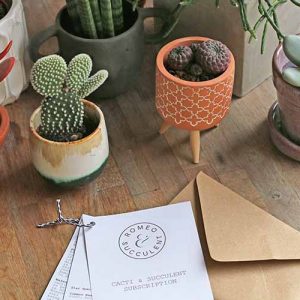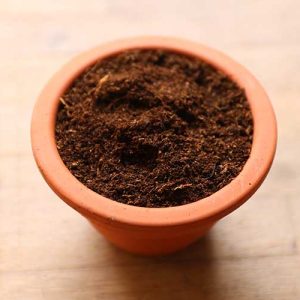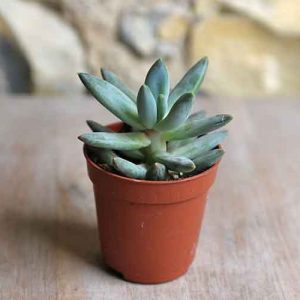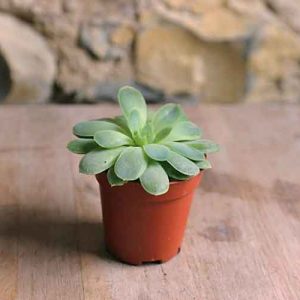HOW TO CARE FOR YOUR ECHEVERIA (CLASSIC SUCCULENTS)
THE CLASSIC SUCCULENT
Echeveria genus. Common Types: Mexican Firecracker / Briar Rose / Desert Saviour
Covering a huge variety of flowering and non-flowering succulents, echeveria come in an astounding range of shapes and colours. In fact, there are over one thousand different varieties of this extremely popular genus. These sweet little plants are so easy to love. They’re kind of pudgy, uber cute and most brilliantly, very, VERY easy to look after. These succulents grow in attractive little rosettes and make an excellent addition to terrariums, indoor gardens and hanging planters alike!
Where Does It Come From?
Native to Mexico, Central America and the arid northwestern parts of South America, the echeveria’s unfussy needs are a product of their harsh environments. They thrive in drought and are extremely hardy: able to tolerate high temperatures, strong air currents and weeks without water.
Why Should I Get One?
- Just everything! What’s not to love!? Echeveria are beyond cute and practically impossible to kill. One of the most tolerant indoor plant groups there is, these pretty little plants are just perfect for houseplant beginners, as well as being incredibly versatile. The echeveria are wonderful additions to almost any kind of indoor plant fixture.
- Extremely cheap to purchase, and ideal for new plant parents.
How Big Can It Grow?
Varying from subspecies to subspecies, echeveria plants can grow to differing final sizes. They tend to stay quite small, rarely exceeding 30cm or so in height or spread. It’s part of what makes them so darn cute! Echeveria’s spread by producing offshoots from the mother rosettes which can be easily separated from the mother plant and grown in a separate container. Easy to keep contained, the echeveria is perfect for indoor cacti/succulent gardens and terrariums.
Where Should I Keep It?
Echeveria are exceptionally tolerant. They can accept warmth, blazing heat and even dry cold, so usually wherever you place them in your home, they should be just fine. They don’t react brilliantly to the cold and wet combo though, so anywhere where they may be exposed to frost will be too much for them. Native to deserts, the echeveria prefer to bask in bright light and thrive best in well-light spaces full of sunshine, tolerating the heat of full sun with no issues.
Pot-wise, most echeveria prefer loose, sandy soil and can tolerate growing in very small pots. This is part of what makes them such a wonderful choice for those of you building terrariums. These succulents also enjoy non-glazed pots if possible, as it allows the moisture to evaporate more easily.
How Often Should I Water It?
It is essential that you don’t over-water these little treasures. They hate it. Moderate watering every now and then (no more than once per week) will certainly do the trick, and feeding is rarely necessary. As plants that are extremely vulnerable to root-rot, filling the planter with too much moisture can be the end of them. I would recommend letting the soil dry out completely in between waters to avoid this problem.
You really cannot go wrong with an echeveria. Whether you are cultivating an indoor succulent garden, designing a funky geometric terrarium, or curating a stunning hanging basket, trust me, out there somewhere is the perfect echeveria for you!
-
 Sold OutSelect options This product has multiple variants. The options may be chosen on the product page quick viewQuick View
Sold OutSelect options This product has multiple variants. The options may be chosen on the product page quick viewQuick View3 or 6 Month Gift Subscription (Cacti & Succulent Plant Subscription)
Lifestyle: Gifts, Kits & More, Plant Subscriptions, View All £60.00 – £120.00 -
Quick View
Mini Spike Succulent (Echeveria Hookerii)
Baby House Plants, Cacti + Succulents, Mini Terrarium Plants, View All £3.00 -
Quick View
Mini Succulent (Echeveria)
View All, Mini Terrarium Plants, Cacti + Succulents, Baby House Plants £3.00 -
 Sold OutSelect options This product has multiple variants. The options may be chosen on the product page quick viewQuick View
Sold OutSelect options This product has multiple variants. The options may be chosen on the product page quick viewQuick ViewSoil for Cacti and Succulents
View All, Terrarium Moss, Decor + Tools, Soil, Grit + Gravel £3.00 – £3.50


